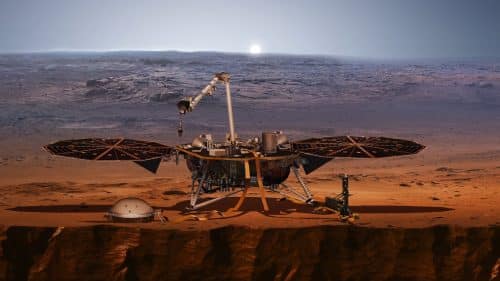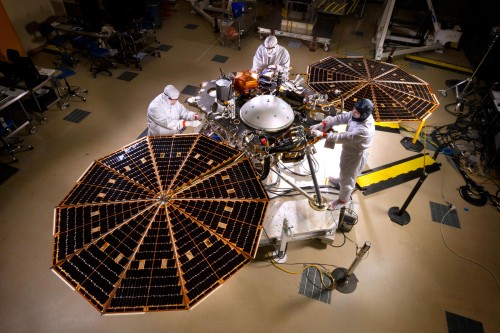The planet Mars is a kind of time machine. Its small size relative to the Earth and Venus meant that the erosive activity of the atmosphere is not enough to erase the history from the time of the formation of the solar system * Now the spacecraft will have to reach Mars and survive the descent into the atmosphere and the landing, which history proves is not trivial.

This morning at 04:05 West Coast Time, 14:05 Israel Time, an Atlas V model launcher was launched from the Vandenberg Space Base in California, carrying the MARS INSIGHT spacecraft - designed to study the geology of Mars.
The journey so far (about half an hour after the launch) is going smoothly, when in about an hour the second stage of the Atlas launcher will be fired again to accelerate the spacecraft's speed and take it out of orbit around the Earth towards Mars.
Due to the location of the launch in California, it is not possible to launch east, so the spacecraft was launched a little west and then, when it was over the Pacific Ocean, it turned southeast towards the west coast of the Gulf of Baja California in Mexico. When it reached orbit around the earth, from southwest to northeast.
In any case, even when it leaves Earth's orbit safely, it must reach Mars safely, and pass the stages of atmospheric descent and landing, a stage in which many spacecraft have failed.
All of NASA's interplanetary launches to date have been carried out from the Kennedy Space Center in Cape Canaveral, Florida. Partly because the physics of East Coast launches are better for journeys to other planets. Insight broke that mold by launching from Vandenberg Air Force Base in central California. Insight was launched on ULA's Model 401 Atlas V launcher - which allows reaching Mars orbit from both coasts and was ultimately chosen because it had better availability. At the time of launch, five in the morning WST it was still dark and the fire trail of the launcher could be seen from many places in California.

Why the InSight mission to Mars is different from its predecessors
NASA has a long track record on Mars since 1965. The American space agency has launched spacecraft that have orbited, landed and even traveled on the Martian soil. However, only about 40% of the missions sent managed to reach their destination. The planet's thin atmosphere makes landing a challenge. The extreme heat makes it difficult to operate the spacecraft on the surface, but if it survives the trip, there is plenty of science for it to collect.
Well what does the InSight spacecraft do that its predecessors did not?
InSight is the first mission to explore the Martian subsurface. The dictionary definition of her name is insight - to understand the inner nature of something. The InSight spacecraft will do this through seismic testing, geodesy and heat conduction. Insight will measure the vital signs of Mars - its pulse (seismology), its temperature (heat flow) and its reflexes (radio science).
InSight will teach us about the internal composition of planets like ours. The InSight team hopes that by studying the interior of Mars we can learn how other rocky worlds, including Earth and the Moon, formed. Our planet and Mars were formed from the same primordial material more than 4.5 billion years ago, but then they became completely different. Why didn't they have the same fate?
When it comes to rocky planets, we only know one example in detail - Earth. By comparing Earth's surface to that of Mars, InSight team members hope to better understand our solar system. What they discover may even aid in the search for planets outside the solar system, to focus on those that might support life. So although InSight is a spacecraft that studies Mars, it will help much more than that.
2. InSight will try to detect Martian tremors for the first time
3.
One of the main ways that Insight will peer inside Mars will be through the study of underground movement, what we know as Martian tremors. NASA has been trying to do this since the Viking missions in 1976. Both Viking spacecraft contained a seismometer and therefore also picked up a lot of noise. However, Insight's seismometer will be placed directly on the ground of Mars and will be able to provide much cleaner data.
So far, much evidence has been discovered that suggests that the Martian soil also shakes, but unlike the earthquakes on Earth caused by the movement of tectonic plates, Martian earthquakes are caused by various types of tectonic activity such as volcanic eruptions and cracks that form in the planet's crust, as well as the impact of meteorites The Martian surface can produce seismic waves that InSight will try to detect.
Each such tremor will be like a flash that will clarify the structure of the planet. By studying the effect of the passage of the seismic wave in the different layers of the Martian atmosphere (crust, mantle and core), scientists can deduce the depth and composition of these layers. In this way, seismology is a kind of 'x-ray' of the subsurface on Mars.
Mission scientists estimate that InSight will detect between a dozen and a hundred Martian quakes during a Martian year - or two Earth years. The tremors will not reach magnitude 6 but they will be accompanied by an abundance of energy that will reveal the secrets of Mars.
Insight can teach us how Martian volcanoes formed
Mars is home to some impressive volcanic formations. Among other things, an area known as Tharsis - a plain with some of the largest volcanoes in the solar system. The heat escaping from the depth of the planet is the one that created these formations and also many others on the heat planets to escape from the depth of the earth, driving the formation of the rocky cult types. The Insight lander includes the ability to test the flow of heat on its own and is equipped with a special excavator that will allow it to dig up to a depth of five meters into the Martian soil to measure the flow of heat from inside the planet for the first time. Combining the rate of heat flow with other InSight instrument data will allow us to discover how the internal energy of Mars caused changes on the surface.
. Mars is a time machine
Mars exploration allows us to travel to the ancient past. While Earth and Venus have tectonic systems that have destroyed most evidence of their early history, most of the Red Planet has remained static for more than 3 billion years. Because Mars is only a third the size of Earth and Venus, it contains less energy to drive processes that change the surface of the planet. This feature makes it a fossilized planet in many ways, with the secrets of our solar system's history locked deep inside.
First cubesats outside Earth orbit.
Artist's impression of two cubesats orbiting Mars. Marco is the first cubesat mission into deep space
The rocket that launched Insight into the orbit that will bring it to Mars will release a separate technological experiment - the so-called Marco - two tiny spacecraft based on Cubesat - tiny off-the-shelf satellites, whose dimensions are 10 x 10 x 10 centimeters, when up to three such satellites can be connected together to a spacecraft that is 30 centimeters long. These spacecraft, called Marco, will fly on their own to Mars behind InSight.
The purpose of the small satellites is to test new communication equipment for deep space, and with two Marco spacecraft reaching Mars, they may also be used as a relay to transmit INSIGHT data (although of course only as a backup for the satellites orbiting Mars anyway). This will be the first test of spacecraft miniaturization technology that researchers hope can provide a new capability for dedicated missions and create a new type of communication capabilities for Earth.
Of course, the success of Marco spacecraft does not depend on that of InSight and vice versa.
More of the topic in Hayadan:

4 תגובות
Yaron, neither do you
Yaron, if Mars is not a planet, what is?
Mars is not a planet
Even the first manned voyages to the New World did not always reach their destination. Historically, the experiments were worthwhile for humanity. Again I'm not getting into the debate about what it did to the existing inhabitants of the New World: Aztec Indians Native Americans.
Humanity is not nice. What did it do to the old world and the world in general? I think it's good.